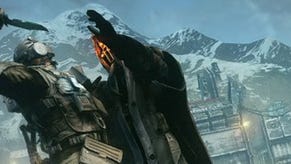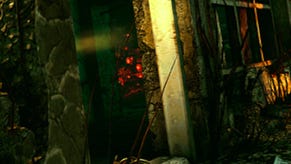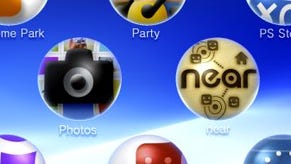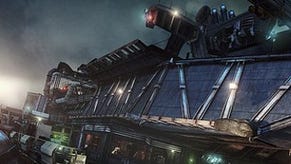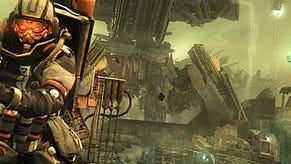World first: Killzone 3's Hermen Hulst on going "above and beyond"
If there's one property that defines gaming fanboyism for this generation, it's Killzone.
The announcement of Killzone 3 this week drags us back five years. A target render of Killzone 2 was shown at E3 in 2005 as a showcase for the capabilities of the incoming PS3, sparking what will go down in history as one of gaming's great first-party controversies.
In the aftermath, SCEA CEO Jack Tretton claimed the footage was gameplay before SCEE's Phil Harrison set the record straight, but the opening shots had been irrecoverably fired in a war still raging.
Hermen Hulst, managing director of Killzone developer Guerilla Games, still stands in the centre of the storm.
It was with great pleasure that we met Hermen in Amsterdam earlier this month, talking to him after seeing the closed premiere of what will surely be a defining videogame for this hardware generation, and one of the most visible first-person shooters in the world when it releases next year.
What follows is a must-read and a world first. Hit the link.
[Interview by Patrick Garratt]
First of all, I want to talk about Killzone 2. The 2005 reveal animation will pretty much go down in gaming history. It was amazing, for all sorts of reasons.
Hermen Hulst: You mean the E3...
Yeah, the target render. Do you think it was fair for your game to be used as a poster boy for PlayStation 3’s capabilities in general? What was it like to be at the centre of that sort of politics?
Hermen Hulst: It’s very much a double-edged sword in many ways. I think, on the downside, it was a humungous amount of pressure. The team, in 2005, was so very, very young. But I think, more importantly on the positive side, that the trailer was our creation. Me and the guys basically worked on it together; our team put it together; it was our vision for the title.
We had researched the capabilities of the PlayStation 3 extensively. We knew what was possible, and that was the vision that was communicated to the team internally, primarily. Then it was communicated externally, and that was the pressure I was talking about. What was great about it is that that’s what we love to do. We’re the kind of team that loves to take a platform and then really squeeze the maximum out of it. It’s very much what we’re about. It’s our DNA.
But going from the release of that trailer to the game's actual ship, the whole development process pretty much defined internet fanboyism for this generation. It became a real beating stick in terms of PS3 and 360. Were you feeling a lot of pressure from the fans, or from Sony, or from yourselves, do you think?
Hermen Hulst: I think the pressure was very general. It’s not so much pressure from Sony as a publisher. Sony’s always been very generous, as you’re well aware, with the amount of time that we were granted to create this game. So that was fantastic. If you put your vision out there, you’re so committed to realising it, and that was a conscious decision. I stood by it all along. We needed to be big enough, and I guess that’s growing pains for a very young team; this was our first truly massive game. Killzone 1 was big, but Killzone 2 was our first big global 3D uptake. I think that’s what it was.
Going onto Killzone 3, then. Is this the game that you originally set out to make? There’s a classic quote from Jeff Haynes on IGN, I think, that said Killzone 2 only managed a 60 percent SPU load. Are you getting close to 90 or 100 percent? Are you realising your vision with Killzone 3?
Hermen Hulst: That’s a great quote, actually. I wasn’t aware of Jeff’s quote. But I think we’re pushing 100 percent right now. You see there’s steam coming out of the machine, almost. All the stuff that we’re squeezing. It’s got everything to do with the scale and the environments and the action that you’re seeing on the screen right now. As I was talking about earlier in the presentation, we’re having a footprint of a level that’s ten times bigger than the average Killzone 2 level. Killzone 2 was not a small game, but that was as far as we could push it back then. We’re going way overboard this time around, and I think we’re reaching the kind of maximum that we can do. But we always do that. We always find a way to go above and beyond.
You said that you’ve been looking at games like Uncharted 2 and God of War III, which really did represent a significant technical step forward. Do you think you’re going to leapfrog them technically and in terms of gameplay innovation? Do you think you’re going to go further?
Hermen Hulst: We need to, right? That’s what we do. We talk to those guys a lot, both the Santa Monica team and the guys at Naughty Dog, and that’s the little game between us as friends of the studios. Yes, we do that, but then again they’re working on their next games and they’re going to have to do better again. So absolutely: we need to do that.
I want to talk about 3D.
Hermen Hulst: Yeah.
Obviously, it’s quite a big deal for the game. You said some really interesting things in that presentation. You said that 3D means you can aim better. That has huge connotations for those that don’t have 3D. Are you saying that if you don’t have a 3D set-up then you’re actually getting a worse experience? Also, there are massive implications for multiplayer there. If someone’s playing in 3D are they going to be able to aim better than an opponent who’s playing in 2D?
Hermen Hulst: That’s a great question. I don’t necessarily think that should be the case. 3D is part of the same build. You’ve seen 2D and 3D right now. It’s something that we switch on. I personally think it helps a lot with reading the environment. The reason you can aim better is that you have more depth, and you can judge where your enemies are based. I actually haven’t tried playing 2D against 3D, so that’s kind of hard for me to answer. I just know that in general, it’s a fantastic way to immerse yourself in that world, to transpose almost, to really feel that you’re there. Because of that, you get a great sense of where you are, for the depth and for the environment. In that sense, it really enhances.
So there’s more object definition, basically?
Hermen Hulst: Yeah. Have you had a chance to...
Not yet.
Hermen Hulst: For instance, if you do a lean and peak, or if you have an object really close and take out your knife, it really comes out of the screen. Other things are pushed back into the screen. It really creates such a deep sense of immersion that it helps you with things such as aiming, because you know where your enemies are. You get a better, more organic feel for where they sit.
Another thing you showed off quite a lot in there was your “brutal melee system”. Can you explain some of the thinking behind including something that’s clearly so very violent in the game? What was the general thinking about including the system? The level of violence will obviously be questioned.
Hermen Hulst: I think brutal melee is just another part of us striving for a very cinematic war experience. As our movies have shown, it’s really cinematic, and particularly that slo-mo. I think that’s the essence of it. It’s a cinematic war experience, and it’s in no way intended to be a real-life experience.
It looks as though it’s QTE-based, and it looks as though it’s quite similar to Heavy Rain. Did you take any cues from Heavy Rain when you were creating the system?
Hermen Hulst: No, even though I know those guys very well, I don’t think there’s been any exchange of specific mechanics or technology with Quantic Dream. As much as I love what they’ve created, there weren’t any triggers from that.
You also said in there that there are more set pieces in the first three minutes of the level you’re showing than there are in an entire Killzone 2 level.
Hermen Hulst: Yes.
Can you just clarify that a little bit in terms of what you actually mean by set piece? How many set pieces were there in a Killzone 2 level?
Hermen Hulst: I personally haven’t counted them; the producers have. But going back to the Corinth River level [in Killzone 2], in the opening sequence you saw that bridge collapse, for instance, and that massive building collapse. Looking at the explosive destructibles that are in there now, all the stuff that’s blowing up; the exploding stuff and the destructible stuff is how we define it.
The levels are gigantic. Is there a capacity, then, to miss set pieces, to skirt around and miss bits of levels? I’m thinking in terms of replayability.
Hermen Hulst: I was just talking to the guys; we really need to put in a Trophy that says you’ve hit everything, to persuade you to go back and hit everything. It’s easy to miss something, for sure. But then again, you probably missed a lot in Killzone 2. That’s just a fact of life. We tried to set up our encounters in such a way that you get to see the most important bits, but when you want to have bigger levels and multiple paths and more exploration, there’s a replayability factor. And that’s fine at the end of the day.
I know you’re not talking about multiplayer today, but you’re going to be talking about it later on in the year, right? Are you going to be talking about it at gamescom?
Hermen Hulst: I don’t know when exactly. We’re going to be talking about that with the PR guys. Definitely later this year we’re going to be giving you more information.
Can you give us a brief overview? I mean, there are a lot of new mechanics in there. You’ve got the jet pack, new weapons...
Hermen Hulst: In the multiplayer, you mean?
Yeah. Is there stuff that we’re seeing today, like the jet pack, going to be accessible in the multiplayer?
Hermen Hulst: I can’t comment on what’s in, whether or not the jet pack is in. We’ll talk about things like that later. I can tell you that it’s massive. I can tell you that it includes a lot of innovation. We’re doing very ambitious things with multiplayer. One of the things we’re striving for is a great deal of accessibility. That’s one of our lessons learned. We want it to be usable for a wider audience. We’re opening it up.
Just talking about mechanics, then. You actually patched the default control settings on Killzone 2 to make them more sensitive. There was a dead-zone issue on the right stick. Are you confident you’re going to be able to avoid a similar situation with Killzone 3?
Hermen Hulst: Absolutely. I think you’re referring to that 1.27 upgrade. We did a big fix back then, but from then onwards we’ve continually improved our controls in terms of responsiveness and in terms of addressing conventions that have arrived. That said, we’re creating a very specific experience, so we’ve been play-testing out controls all along, and I’m very confident that when we come out with Killzone 3 we’ll come out with a game with controls that are very usable and very great to use for the majority of the group.
With Killzone 3, do you think you’re trying to define PlayStation 3 as a console, to define its capabilities?
Hermen Hulst: We always try to do that.
Do you think you will?
Hermen Hulst: I really hope that in some way we achieved that with Killzone 2, and we’re now taking it a step further. You know, 3D is such a big part of our offering, and we’re trying to create the best implementation of a 3D experience, so in that sense, absolutely. Again, that’s what we’re about as Guerilla Games. We keep trying to define PlayStation experiences in every way.
Do you expect the same level of vociferousness from the fans? Do you expect to get bonkers fan feedback?
Hermen Hulst: I can only hope for that, right? The amount of attention we’ve been granted from the community has been absolutely fantastic, and if we get that again, fantastic. Of course, that kind of attention and acclaim is what you want when you create videogames; that’s what you want as a creative; that’s what you do it for. In the meantime we’re trying to create the best possible game, but with Killzone 3 I think we made a very conscientious decision that we are going for a lot of variety.
Looking back at Killzone 2, it really defined what we could do at that specific moment. But we also felt that we could offer a more diverse experience. With Killzone 3 you’re going to see that every single level you play is set in a very unique environment with a specific experience, so that’s probably the starting point for the project.
I went to see Crysis 2 in New York recently, and Crytek were massive on story. It’s a large part of what they talked about: story, story, story. They really see it as a route forward for FPS, that an essential part of modern shooting is to have an integrated plot, and to deliver plot through the environment. Would you agree with that?
Hermen Hulst: Absolutely. I think it’s increasingly important. It used to be that if you created a game that had great gameplay and an improper story, that was fine. Actually, in that regard I think Uncharted 2 has been a game-changer. Those guys have done such a brilliant job with fantastic dialogue that it’s set a new bar, and everyone has to step up. In Killzone 3 specifically, story, dialogue, character-building is a massive deal. We’ve invested a lot. All of our creatives are involved in the story. We’re employing specific talent, and we’re going a lot more Hollywood with our talent casting. In all aspects, then, I would fully agree with that comment.
Last question, then. Are you going to be supporting Move?
Hermen Hulst: Move? So, I can only talk about the features that we’re showing today. I can tell you that Move is a fantastic hardware feature we’ve got, that we’ve had a great time playing party games, and we have SOCOM back at the office. I think it’s a great feature.



